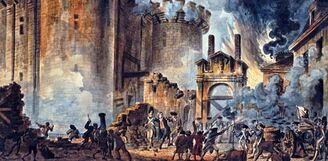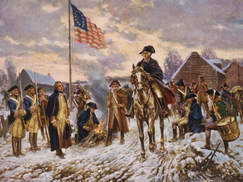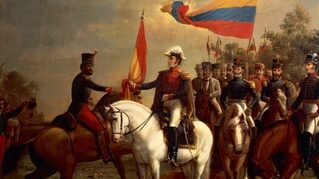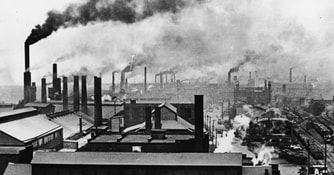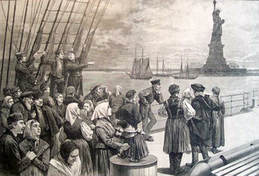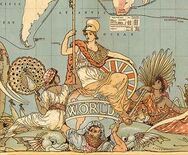Unit Five: Revolutions (c. 1750 to c. 1900)
"A leader is powerful to the degree he empowers others" - unknown source
The Enlightenment and the subsequent revolutions
This unit begins with the overview of how science through observation and experimentation began to change traditional ways and opinions in Western Europe. The following handout on The Scientific Method also incorporates the proving of the heliocentric theory, three theories of the solar system, and key scientists of these times. This lesson then leads into the relationship between the Scientific Revolution and the Enlightenment lesson. Major social and political changes begin to take place within Western Europe with the Enlightenment lesson, "I think, therefore I am." The Enlightenment ideas about government handout validates these changes and special focus is given to a key philosopher Immanuel Kant and his Ideas of the Enlightenment which is a written assignment with key questions. Certain kings and queens in Western Europe believed they were "enlightened" and they are the subject of this Lesson on Enlightened Despots. A subsequent effect of the Enlightenment was the emergence of the city of Vienna, the focus of the Music of the Enlightenment lesson. It was not just music that changed during these times. The following link opens a document with examples of The Arts in the Industrial Age that discusses changes in the Arts as a result of the Industrial Revolution. It covers romanticism, realism, and impressionism as well as a table showing notable people, their countries of origin, and their respective genres.
Special assignment: Document reading with response questions covering Enlightenment Views on Education.
Special assignment: Wollstonecraft v. Rousseau: Are women and men equal?
This unit begins with the overview of how science through observation and experimentation began to change traditional ways and opinions in Western Europe. The following handout on The Scientific Method also incorporates the proving of the heliocentric theory, three theories of the solar system, and key scientists of these times. This lesson then leads into the relationship between the Scientific Revolution and the Enlightenment lesson. Major social and political changes begin to take place within Western Europe with the Enlightenment lesson, "I think, therefore I am." The Enlightenment ideas about government handout validates these changes and special focus is given to a key philosopher Immanuel Kant and his Ideas of the Enlightenment which is a written assignment with key questions. Certain kings and queens in Western Europe believed they were "enlightened" and they are the subject of this Lesson on Enlightened Despots. A subsequent effect of the Enlightenment was the emergence of the city of Vienna, the focus of the Music of the Enlightenment lesson. It was not just music that changed during these times. The following link opens a document with examples of The Arts in the Industrial Age that discusses changes in the Arts as a result of the Industrial Revolution. It covers romanticism, realism, and impressionism as well as a table showing notable people, their countries of origin, and their respective genres.
Special assignment: Document reading with response questions covering Enlightenment Views on Education.
Special assignment: Wollstonecraft v. Rousseau: Are women and men equal?
The terms compare and contrast and cause and effect are key components of the Enlightenment as the ideas created during this era lead to a series of global revolutions. The first will start in the 1700's in North America and is seen with the Key political events prior to the American Revolution chart. The philosophies of the Enlightenment and the end of the Thirteen Colonies gives hope of freedom to other nations.
The first is a lesson on the French Revolution followed by an illustrated presentation of the French Revolution. The three men during the French Revolution political cartoon is an excellent example between the social struggles in France that was a major underlying cause of the revolution. An interesting view of society in these times is a short lesson on Clothing worn by the people of France during the age of revolution.
Special Assignment: Regents level, Short-Answer Constructed Response Questions (CRQ) - Two Views of the French Revolution
Was the French Revolution a success or a failure? The full story cannot be really answered until one examines the story of Napoleon Bonaparte. The Declaration of the Rights of Man and of the Citizen was a major change enacted by him along with a change of the entire legal system found in the extract from the Napoleonic Code of Laws handout. Napoleon did not only want to rule France but he wanted to conquer the world. His campaign is shown in the following map of Napoleon's Empire . However, he made several costly mistakes which would eventually cost him his empire.
Special assignment: Will the real Napoleon Bonaparte stand up? What was life like under the rule of Napoleon might be found in this handout Two Views of Napoleon. Read and analyze the two extracts then answer the questions that follow using complete sentences.
The first overseas response to the French Revolution was the slave revolt in Haiti which in turn led to others as seen in the presentation on the Latin American Revolutions. The geographic location of both Haiti and New Orleans can be seen in this map. At this time, Thomas Jefferson seized the opportunity of the revolt in Haiti and approached Napoleon to buy the port of New Orleans. America doubled in size overnight and the following link are a series of maps showing the extent of the Louisiana Purchase.
Who were the Latin American Revolutionaries? This link is an in-depth look of these people and how Latin America changed in part to other revolutions and the ideas of the Enlightenment. An in-depth insight as to the reasons for these revolutions can be found in writings of Simon Bolivar lesson and questions on The Jamaica Letters.
The first is a lesson on the French Revolution followed by an illustrated presentation of the French Revolution. The three men during the French Revolution political cartoon is an excellent example between the social struggles in France that was a major underlying cause of the revolution. An interesting view of society in these times is a short lesson on Clothing worn by the people of France during the age of revolution.
Special Assignment: Regents level, Short-Answer Constructed Response Questions (CRQ) - Two Views of the French Revolution
Was the French Revolution a success or a failure? The full story cannot be really answered until one examines the story of Napoleon Bonaparte. The Declaration of the Rights of Man and of the Citizen was a major change enacted by him along with a change of the entire legal system found in the extract from the Napoleonic Code of Laws handout. Napoleon did not only want to rule France but he wanted to conquer the world. His campaign is shown in the following map of Napoleon's Empire . However, he made several costly mistakes which would eventually cost him his empire.
Special assignment: Will the real Napoleon Bonaparte stand up? What was life like under the rule of Napoleon might be found in this handout Two Views of Napoleon. Read and analyze the two extracts then answer the questions that follow using complete sentences.
The first overseas response to the French Revolution was the slave revolt in Haiti which in turn led to others as seen in the presentation on the Latin American Revolutions. The geographic location of both Haiti and New Orleans can be seen in this map. At this time, Thomas Jefferson seized the opportunity of the revolt in Haiti and approached Napoleon to buy the port of New Orleans. America doubled in size overnight and the following link are a series of maps showing the extent of the Louisiana Purchase.
Who were the Latin American Revolutionaries? This link is an in-depth look of these people and how Latin America changed in part to other revolutions and the ideas of the Enlightenment. An in-depth insight as to the reasons for these revolutions can be found in writings of Simon Bolivar lesson and questions on The Jamaica Letters.
After the surrender of Napoleon, a power struggle developed in Western Europe and nationalism swept across the continent. The Congress of Vienna handout tells of the agreements made that restricted any one nation becoming more powerful than others. This is also illustrated in the map of Europe after the Congress of Vienna.
The Industrial Revolution
Believe it or not, the Industrial Revolution in Western Europe begins with major changes in agriculture.
Previously, there have been two major changes in agriculture. The first came with the Neolithic Revolution, the second with Feudalism in Western Europe and the three-field rotation and now there was The Agrarian Revolution in England. Labor-saving devices led to massive urbanization which in turn leads into the lesson on The Industrial Revolution. Why did this era see the start of British global dominance? The answer can be found in my illustrated presentation on The Industrial Revolution.
To validate the above lesson and presentation, I have added several very useful documents that will help better understand the times. They are a map of the Growth of British Cities during the Industrial Revolution, maps of British coalfields and the growth of British Railways during the Industrial Revolution. The invention of the steam engine and then the steam train led to a period of sweeping change across England. One of my favorite lessons is a first-hand account of a famous British actress being taken as a special guest on the Liverpool to Manchester Railroad. Her vivid descriptions of the steam train and her emotions during the journey adds so much to her story.
The next set of handouts focus on specific key subjects to this section: the Textile Industry of Britain, Textile Machines of the Industrial Revolution and a lesson on Early Child Labor in America which mimics what life was like in a British factory town.
A Special link: Hometown video
However, there were exceptions to the harsh working conditions, child labor, and women working in the factories. I was fortunate to have visited Saltaire in the north of England that was a factory textile town built by Sir Titus Salt. These photos will validate the entire subject of the lecture.
Special Assignment: Analyzing a political cartoon: Capital and Labour
Special Assignment Lesson on Industrial Revolution Machines.
Economics plays a major role in the development of British industry and this is explained in the characteristics of early capitalism handout. As time progressed, more and more inventions were created and the demand for new types of raw materials increased. Over time, British superiority declines due to competition from other European countries and this next link opens to a map showing the spread of the Industrial Revolution across Western Europe. It was then only a matter of time before the new machines reached across the Atlantic Ocean and the following is to a presentation showing the Second Industrial Revolution in America.
Fast forward to the world today and the following is about Urbanization and Modernization today.
Special Assignment: understanding charts and tables using demographics. Open the attached link, analyze the table on Populations of Western Europe from 1700 to 1850 and answer the questions that follow using complete sentences.
Previously, there have been two major changes in agriculture. The first came with the Neolithic Revolution, the second with Feudalism in Western Europe and the three-field rotation and now there was The Agrarian Revolution in England. Labor-saving devices led to massive urbanization which in turn leads into the lesson on The Industrial Revolution. Why did this era see the start of British global dominance? The answer can be found in my illustrated presentation on The Industrial Revolution.
To validate the above lesson and presentation, I have added several very useful documents that will help better understand the times. They are a map of the Growth of British Cities during the Industrial Revolution, maps of British coalfields and the growth of British Railways during the Industrial Revolution. The invention of the steam engine and then the steam train led to a period of sweeping change across England. One of my favorite lessons is a first-hand account of a famous British actress being taken as a special guest on the Liverpool to Manchester Railroad. Her vivid descriptions of the steam train and her emotions during the journey adds so much to her story.
The next set of handouts focus on specific key subjects to this section: the Textile Industry of Britain, Textile Machines of the Industrial Revolution and a lesson on Early Child Labor in America which mimics what life was like in a British factory town.
A Special link: Hometown video
However, there were exceptions to the harsh working conditions, child labor, and women working in the factories. I was fortunate to have visited Saltaire in the north of England that was a factory textile town built by Sir Titus Salt. These photos will validate the entire subject of the lecture.
Special Assignment: Analyzing a political cartoon: Capital and Labour
Special Assignment Lesson on Industrial Revolution Machines.
Economics plays a major role in the development of British industry and this is explained in the characteristics of early capitalism handout. As time progressed, more and more inventions were created and the demand for new types of raw materials increased. Over time, British superiority declines due to competition from other European countries and this next link opens to a map showing the spread of the Industrial Revolution across Western Europe. It was then only a matter of time before the new machines reached across the Atlantic Ocean and the following is to a presentation showing the Second Industrial Revolution in America.
Fast forward to the world today and the following is about Urbanization and Modernization today.
Special Assignment: understanding charts and tables using demographics. Open the attached link, analyze the table on Populations of Western Europe from 1700 to 1850 and answer the questions that follow using complete sentences.
|
|
The video on the left is a song by a British band from the 1980's called Dream Academy. The title of the song is "Life in a Northern Town." The video is shot in Northern England, in an old mill town from the Industrial Revolution that like many more, still exist today. The lyrics are about young people growing up in this old factory town. The background scenes depict what life is still like; cobble-stone streets with back-to-back houses all in a row in the river valley that was once the water-power for the factories.
|
Global Migrations
The technological developments of the Industrial Revolution including the railways and steamboats combined with political changes led to a time of the mass movement of difference people around the world. The first document in this section is an overview lesson to Global Migrations which is followed by the Irish Potato Famine handout, one of the largest displacements of people due to famine and political unrest. A tribute to these needy people can be found at the Irish Potato Famine cottage monument in lower New York City and these photographs were taken on a previous visit. Fleeing one's country in a time of need means that many left their homelands in poverty and despair and the following documents highlight such events. Who were these people that came to find freedom and wealth? Part of the answer can be found in the following document, the Changing Patterns of Immigration in North America. How do you accommodate so many people? The next handouts gives an insight into Steerage and how immigrants traveled. If you survived the transit then life was still hard and this is illustrated by the Urban Problems, as seen in North America.
On the Statue of Liberty in New York Harbor is a poem, the New Colossus, written by Emma Lazars, that reads:
Give me your tired, your poor,
Your huddled masses yearning to breathe free,
The wretched refuse of your teeming shore.
Send these, the homeless, tempest-tossed to me,
I lift my lamp beside the golden door!
Give me your tired, your poor,
Your huddled masses yearning to breathe free,
The wretched refuse of your teeming shore.
Send these, the homeless, tempest-tossed to me,
I lift my lamp beside the golden door!
However, not everyone was welcome in America, especially the Chinese. The following documents cover their plight. It is the story of the "coolies." Chinese Emigration in the 19th century and the Chinese Exclusion Act of 1882 tell of discrimination against one specific race of people.
The geographical area called Oceania is part of the curriculum and before we look at two indigenous peoples of this region, it is best to study and learn the maps on the regions and migrations of Oceania.
Many Irish and British citizens migrated farther afield and the following lessons cover the History of Australia and the History of New Zealand.
The geographical area called Oceania is part of the curriculum and before we look at two indigenous peoples of this region, it is best to study and learn the maps on the regions and migrations of Oceania.
Many Irish and British citizens migrated farther afield and the following lessons cover the History of Australia and the History of New Zealand.
Unification and Nationalism
The rise of nationalism during this era is best seen with the Unification of Italy and then with the Unification of Germany that will lead to these new countries being formed an political changes that will subsequently result in two world wars. To supplement these lessons I have added a document called The Dedication of Young Italy that focuses on the revolutionary movement and oath ceremony created by Giuseppe Mazzini and a handout titled Bismarck's Formula for Success that gives further insight into the thinking and actions of Otto von Bismarck. To better understand the success of Unification in Germany, this link opens a map tat shows the Germanic speaking regions of Western Europe prior to Unification.
The rise of nationalism during this era is best seen with the Unification of Italy and then with the Unification of Germany that will lead to these new countries being formed an political changes that will subsequently result in two world wars. To supplement these lessons I have added a document called The Dedication of Young Italy that focuses on the revolutionary movement and oath ceremony created by Giuseppe Mazzini and a handout titled Bismarck's Formula for Success that gives further insight into the thinking and actions of Otto von Bismarck. To better understand the success of Unification in Germany, this link opens a map tat shows the Germanic speaking regions of Western Europe prior to Unification.
